
The Book of Jonah is collected as one of the twelve minor prophets of the Nevi'im ("Prophets") in the Hebrew Bible, and as a book in its own right in the Christian Old Testament. The book tells of a Hebrew prophet named Jonah, son of Amittai, who is sent by God to prophesy the destruction of Nineveh, but tries to escape this divine mission.

The Book of Nahum is the seventh book of the 12 minor prophets of the Hebrew Bible. It is attributed to the prophet Nahum, and was probably written in Jerusalem in the 7th century BC.

Jonah or Jonas, son of Amittai, is a prophet in the Hebrew Bible and the Quran, from Gath-hepher of the northern kingdom of Israel in about the 8th century BCE. Jonah is the central figure of the Book of Jonah, which details his reluctance in delivering God's judgement on the city of Nineveh, and then his subsequent, albeit begrudged, return to the divine mission after he is swallowed by a large sea creature.

Nineveh was an ancient Assyrian city of Upper Mesopotamia, located in the modern-day city of Mosul in northern Iraq. It is located on the eastern bank of the Tigris River and was the capital and largest city of the Neo-Assyrian Empire, as well as the largest city in the world for several decades. Today, it is a common name for the half of Mosul that lies on the eastern bank of the Tigris, and the country's Nineveh Governorate takes its name from it.

The Hanging Gardens of Babylon were one of the Seven Wonders of the Ancient World listed by Hellenic culture. They were described as a remarkable feat of engineering with an ascending series of tiered gardens containing a wide variety of trees, shrubs, and vines, resembling a large green mountain constructed of mud bricks. It was said to have been built in the ancient city of Babylon, near present-day Hillah, Babil province, in Iraq. The Hanging Gardens' name is derived from the Greek word κρεμαστός, which has a broader meaning than the modern English word "hanging" and refers to trees being planted on a raised structure such as a terrace.
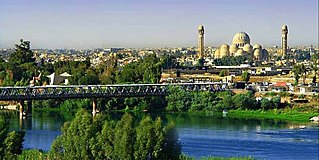
Nineveh Governorate, also known as Ninawa Governorate, is a governorate in northern Iraq. It has an area of 37,323 km2 (14,410 sq mi) and an estimated population of 2,453,000 people as of 2003. Its largest city and provincial capital is Mosul, which lies across the Tigris river from the ruins of ancient Nineveh. Before 1976, it was called Mosul Province and included the present-day Dohuk Governorate. The second largest city is Tal Afar, which has an almost exclusively Turkmen population.

Nimrud is an ancient Assyrian city located in Iraq, 30 kilometres (20 mi) south of the city of Mosul, and 5 kilometres (3 mi) south of the village of Selamiyah, in the Nineveh Plains in Upper Mesopotamia. It was a major Assyrian city between approximately 1350 BC and 610 BC. The city is located in a strategic position 10 kilometres (6 mi) north of the point that the river Tigris meets its tributary the Great Zab. The city covered an area of 360 hectares. The ruins of the city were found within one kilometre (1,100 yd) of the modern-day Assyrian village of Noomanea in Nineveh Governorate, Iraq.

Assyriology is the archaeological, anthropological, and linguistic study of Assyria and the rest of ancient Mesopotamia and of the related cultures that used cuneiform writing. The field covers Sumer, the early Sumero-Akkadian city-states, the Akkadian Empire, Ebla, the Akkadian and Imperial Aramaic speaking states of Assyria, Babylonia and the Sealand Dynasty, the migrant foreign dynasties of southern Mesopotamia, including the Gutians, Amorites, Kassites, Arameans, Suteans and Chaldeans.
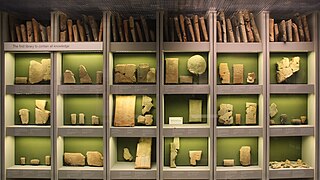
The Royal Library of Ashurbanipal, named after Ashurbanipal, the last great king of the Assyrian Empire, is a collection of more than 30,000 clay tablets and fragments containing texts of all kinds from the 7th century BC, including texts in various languages. Among its holdings was the famous Epic of Gilgamesh.

Isaac of Nineveh, also remembered as Saint Isaac the Syrian, Abba Isaac, Isaac Syrus and Isaac of Qatar, was a 7th-century Church of the East Syriac Christian bishop and theologian best remembered for his written works on Christian asceticism. He is regarded as a saint in the Assyrian Church of the East, the Catholic churches, Oriental Orthodoxy and Eastern Orthodox tradition. His feast day falls, together with 4th-century theologian and hymnographer St. Ephrem the Syrian, on January 28.

The Battle of Nineveh is conventionally dated between 613 and 611 BC, with 612 BC being the most supported date. Rebelling against the Assyrians, an allied army which combined the forces of Medes and the Babylonians, besieged Nineveh and sacked 750 hectares of what was, at that time, one of the greatest cities in the world. The fall of Nineveh led to the destruction of the Neo-Assyrian Empire over the next three years as the dominant state in the Ancient Near East. Archeological records show that the capital of the once mighty Assyrian Empire was extensively de-urbanized and depopulated in the decades and centuries following the battle. A garbled account of the fall of the city later led to the story of the legendary king Sardanapalus.

Nineveh Plains is a region in Nineveh Governorate in Iraq, to the north and east of the city Mosul. Control over the region is contested between Iraqi security forces, KRG security forces, Assyrian security forces, Babylon Brigade and the Shabak Militia.
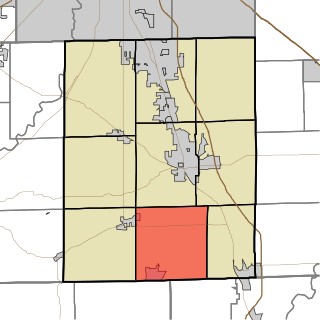
Nineveh Township is one of nine townships in Johnson County, Indiana. As of the 2010 census, its population was 3,987 and it contained 1,688 housing units. Nineveh Township took its name from Nineveh Creek.
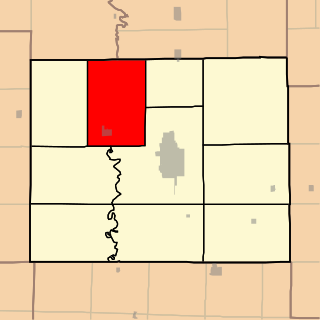
Nineveh Township is one of ten townships in Adair County, Missouri, United States. As of the 2010 census, its population was 1,289. The township is named from the town of Nineveh, a German communistic colony that was established in the area in about 1850.
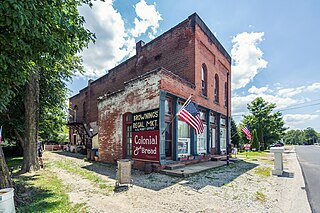
Nineveh is an unincorporated community in Nineveh Township, Johnson County, Indiana, United States.
Nineveh is an unincorporated community in Nineveh Township, Adair County, Missouri, United States.

Nineveh is an unincorporated community in Greene County, in the U.S. state of Pennsylvania.
Nineveh Township is an inactive township in Lincoln County, in the U.S. state of Missouri.

The Nineveh Plain Forces or NPF was a military organization that was formed on 6 January 2015 by the indigenous Christian Assyrian people in Iraq, in cooperation with Peshmerga, to defend against Islamic State. The Nineveh Plains is a region at the heart of the Assyrian homeland. The militia is affiliated with the Bet-Nahrain Democratic Party and the Beth Nahrain Patriotic Union (HBA), the latter being part of the secular Dawronoye movement. It participated in the Battle of Mosul (2016–2017).
Nineveh is an unincorporated community in Warren County, Virginia, on the main road between Winchester, Virginia, and Front Royal, Virginia. Prior to the creation of Warren County in 1836, Nineveh was in Frederick County, Virginia. A post office at Nineveh operated from the early 1800s until closing in 1954.
















